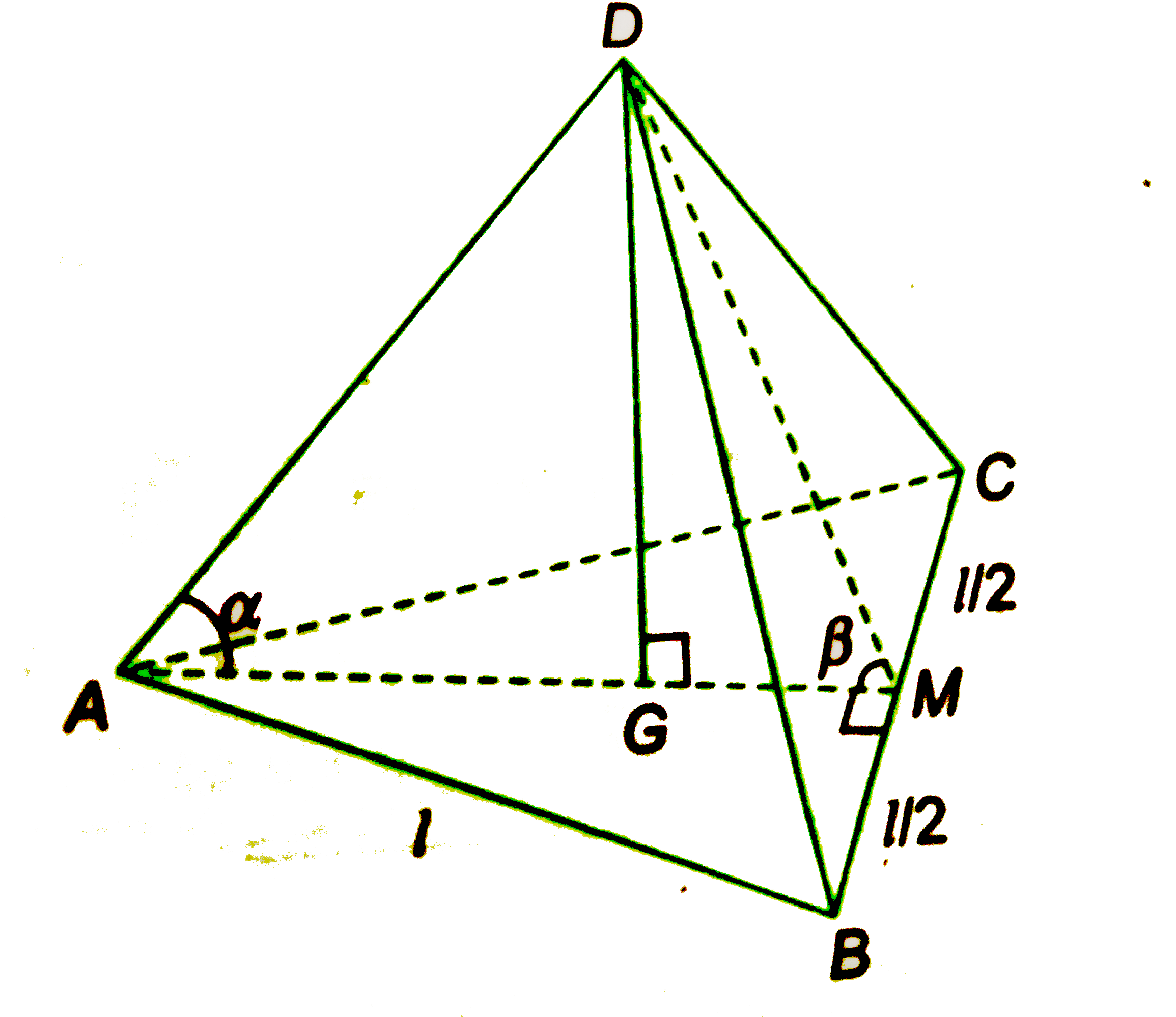find the height of the regular pyramid with each edge measuring l cm.
Also,
(i) if α is angle between any edge and face not containing that edge, then prove that cosα=1√3
(ii) if β is the between the two faces, then prove that cosβ=13
In the figure we have regular pyramid.

All the edges have length l cm.
So, each face of the pyramid is an equilateral triangle.
From vertex D drop perpendicular to meet opposite face ABC at point G, which is the centre of the triangle ABC.
Here, G is also centroid of triangle ABC as it an equailateral triangle.
Clearly, AG=23AM
In triangle AMB,AM=ABsin60∘=√32lcm
∴AG=23×AM=23×√32l=12√3lcm
In triangle AGD, using Pythagoras, we get
AD2=AG2+GD2
∴l2=13l2+GD2
∴GD=√231cm
For angle between any edge and face not containing that edge, consider edge AD and face ABC.
Angle between them is α,which is angle between AD and AM.
In triangle AGD, cosα=AGAD=1√3ll=1√3
Angle between two faces ABC and BCD is the angle between AM and DM, which is β.
In triangle DGM,cosβ=GMDM=13
Topper's Solved these Questions
- BOOK - CENGAGECHAPTER - TRIGONOMETRIC FUNCTIONS EXERCISE - Exercise 2.18videos
TRIGONOMETRIC FUNCTIONS
- BOOK - CENGAGECHAPTER - TRIGONOMETRIC FUNCTIONS EXERCISE - Exercise 2.28videos
TRIGONOMETRIC FUNCTIONS
- BOOK - CENGAGECHAPTER - TRIGONOMETRIC EQUATIONSEXERCISE - Archives (Matrix Match Type)1videos
TRIGONOMETRIC EQUATIONS
- BOOK - CENGAGECHAPTER - TRIGONOMETRIC RATIOS AND TRANSFORMATION FORMULASEXERCISE - Matrix Match Type1videos
TRIGONOMETRIC RATIOS AND TRANSFORMATION FORMULAS
Similar Questions
Knowledge Check
- Question 1 - Select One
The total surface area of a regular triangular pyramid with each edge of length 1 cm is
A4√3cm2B43√3cm2C√3cm2D4cm2 - Question 2 - Select One
Comprehesion-I
Let k be the length of any edge of a regular tetrahedron (all edges are equal in length). The angle between a line and a plane is equal to the complement of the angle between the line and the normal to the plane whereas the angle between two plane is equal to the angle between the normals. Let O be the origin and A,B and C vertices with position vectors →a,→b and →c respectively of the regular tetrahedron.
The angle between any edge and a face not containing the edge isAcos−1(12)Bcos−1(14)Ccos−1(1√3Dcos−1(√32) - Question 3 - Select One
Comprehesion-I
Let k be the length of any edge of a regular tetrahedron (all edges are equal in length). The angle between a line and a plane is equal to the complement of the angle between the line and the normal to the plane whereas the angle between two plane is equal to the angle between the normals. Let O be the origin and A,B and C vertices with position vectors →a,→b and →c respectively of the regular tetrahedron.
The angle between any two faces isAcos−1(1√2)Bcos−1(14)Ccos−1(√32)Dcos−1(12)
The angle between one of the diagonals of a cube and one of its edge is θ then √3cosθ=
View SolutionLet k be the length of any edge of a regular tetrahedron (a tetrahedron whose edges are equal in length is called a regular tetrahedron). Show that the angle between any edge and a face not containing the edge iscos−1(1/√3) .
View SolutionIf αandβ are acute angles and cos2α=3cos2β−13−cos2β. Prove that : tanα=√2tanβ.
View SolutionFind the lateral surface area of a regular pyramid with triangular base, if each edge of the base measures 8 cm and slant height is 5 cm.
 View Solution
View SolutionComprehesion-I
Let k be the length of any edge of a regular tetrahedron (all edges are equal in length). The angle between a line and a plane is equal to the complement of the angle between the line and the normal to the plane whereas the angle between two plane is equal to the angle between the normals. Let O be the origin and A,B and C vertices with position vectors →a,→b and →c respectively of the regular tetrahedron.
The value of [→a→b→c]2 isView Solution

